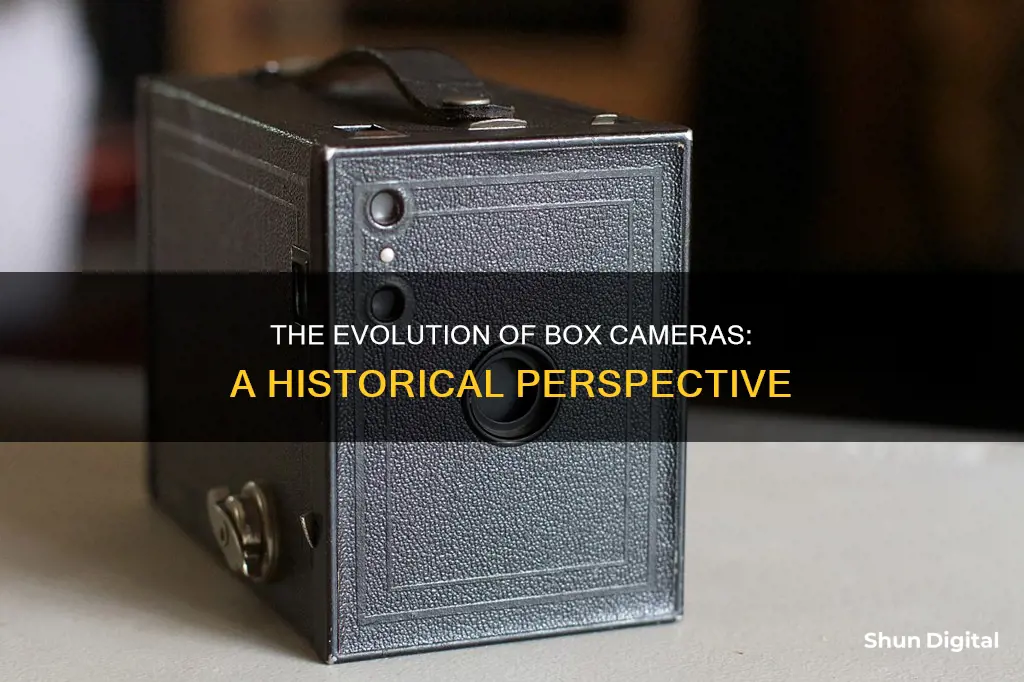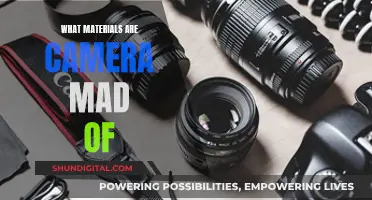
Box cameras are the earliest class of camera type, originating in the 19th century. The first camera ever used for making persistent photographic images was a big wooden box camera used by Nicéphore Niépce for experimental photography in the mid-1820s. However, box cameras were mass-produced and became extremely popular after the introduction of the first Kodak in 1888. The Kodak camera was a simple wooden box with a barrel shutter and came pre-loaded with enough paper-based film to make 100 images. Once the user had exposed the film, they sent it back to the factory to be reloaded and returned to the customer while the first roll was being processed.
| Characteristics | Values |
|---|---|
| When were box cameras first made? | The first box camera was used in the mid-1820s by Nicéphore Niépce for experimental photography. |
| When did box cameras become popular? | Box cameras became popular in the late 19th and early 20th centuries. |
| Who invented the box camera? | The box camera was invented by George Eastman and marketed in 1888 as the "Kodak". |
| What was the first box camera made of? | The first box camera was made of wood. |
| What type of film did the first box camera use? | The first box camera used a 100-exposure roll of paper film. |
| How much did the first box camera cost? | The first box camera cost $25. |
| How many images could be taken with the first box camera? | The first box camera could take 100 images. |
| What was the procedure for processing the film of the first box camera? | The user sent the camera back to the factory to be reloaded and processed. |
| What was the cost of processing the film for the first box camera? | The subsequent cost of processing the film was $10. |
| What was the slogan used to market the first box camera? | "You press the button, we do the rest". |
What You'll Learn

The Kodak Box Camera
The Kodak Brownie was a series of box camera models made by Eastman Kodak and first released in 1900. It was invented by Frank A. Brownell for the Eastman Kodak Company and was initially aimed at children. Named after the Brownie characters popularised by the Canadian writer Palmer Cox, the Brownie cost a mere 5 shillings in the United Kingdom (or $1 in the US) and took 2+1⁄4-inch square pictures on No. 117 roll film. More than 150,000 Brownie cameras were shipped in the first year of production.
The Brownie was a basic cardboard box camera with a simple convex-concave lens. It was conceived and marketed to sell Kodak roll films, which were also affordable at a low price. The camera's simple controls and low price, along with the low cost of Kodak roll film and processing, made the Brownie camera a huge success.
In 1901, an improved model, called the No. 2 Brownie, was released. It produced larger 3.25-by-2.25-inch (1.44:1 aspect ratio) photos and cost $2. This model was also a huge success, appealing to both children and adults who realised that the camera could produce very good results under the right conditions.
The Kodak Brownie continued to evolve and spawn many varieties, such as a Boy Scout edition in the 1930s. In 1940, Kodak released the Six-20 Flash Brownie, its first internally synchronized flash camera, using General Electric bulbs. In 1957, Kodak produced the Brownie Starflash, its first camera with a built-in flash.
The Brownie 127 was popular, selling in the millions between 1952 and 1967. It was a bakelite camera with a simple meniscus lens and a curved film plane to compensate for the deficiencies of the lens. Another model was the Brownie Cresta, sold between 1955 and 1958. It used 120 film and had a fixed-focus lens.
The last official Brownie camera made was the Brownie II Camera, a 110 cartridge film model produced in Brazil for one year, 1986. The Kodak Brownie Number 2, manufactured from 1901 to 1935, was a very popular and affordable camera, with many still in use by film photographers today.
New Camera Battery Care: Do's and Don'ts
You may want to see also

Box Cameras for Beginners
Box cameras are the earliest class of camera, originating in the 19th century. They were sold in large numbers during the late 19th and early 20th centuries. The first camera ever used for making persistent photographic images was a big wooden box camera that Nicéphore Niépce used for experimental photography in the mid-1820s.
The Kodak camera, introduced in 1888, was the first box camera to become widely adopted by the public and its design became the archetype for box camera designs. The Kodak Brownie, a long-lasting series of classical box cameras using roll film, was introduced in 1900 and was one of the most successful box cameras ever.
The Brownie operates under the following sequence of events:
- A shutter in the front of the camera is opened, allowing light to pass through the lens. This light is reflected from the object being photographed.
- As the light passes through the lens, it forms an image of the object being photographed. As it continues through the lens, this image is inverted (turned upside down).
- The lens projects the inverted image onto light-sensitive film at the back of the box. This is known as the exposure of the film. The longer the shutter is left open, the more light is allowed onto the film.
Tips for Using a Box Camera
- Since you cannot adjust the focus with this camera, you have to work with aperture and hyper-focal distance to have your subject in focus.
- Box cameras work best in full daylight.
- Photos are taken quickly with no accurate framing.
- Shutter speeds for the Brownie could be pre-set anywhere from 1/25th to 1/50th of a second.
- When using the "bulb" setting, it was necessary to place the Brownie on a firm surface to prevent it from moving during the exposure and the shutter had to be held open manually for the required length of time.
- Most Brownies had viewfinders with a reflex mirror assembly. To compose the picture, it was necessary to hold the camera at waist level and look down into the finder.
- If your Brownie takes square pictures (6cm x 6cm), it will have only one centre viewfinder; if it takes rectangular pictures (6cm x 9cm), it will have two finders, one on the top and one on the side.
- The longer you leave the shutter open, the more light will be allowed onto the film.
Camera Battery Strategy for Wedding Photographers
You may want to see also

Box Cameras for Pretenders
Box cameras, the earliest class of camera type, have come a long way since their inception in the 19th century. The first camera ever used for making persistent photographic images was a big wooden box camera used by Nicéphore Niépce for experimental photography in the mid-1820s. These early cameras were made of two boxes, one inside the other, which allowed the photographer to shift the focus of the image. The daguerreotype photographic technique and other contemporary processes were used with these early cameras.
The Kodak box camera, introduced in 1888, was the first to become widely adopted by the public and its design became the archetype for box cameras. It was invented and marketed by George Eastman, a former bank clerk from Rochester, New York. Eastman's genius lay in his marketing strategy: by simplifying the apparatus and even processing the film for the consumer, he made photography accessible to millions of casual amateurs. The Kodak came pre-loaded with a 100-exposure roll of film, and when the roll was finished, the entire machine was sent back to the factory in Rochester, where it was reloaded and returned to the customer. Eastman launched an advertising campaign featuring women and children operating the camera, with the slogan: "You press the button, we do the rest."
The Brownie, a series of camera models made by Eastman Kodak and first released in 1900, was a basic cardboard box camera with a simple convex-concave lens that took 2+1⁄4-inch square pictures on No. 117 roll film. It was conceived and marketed for sales of Kodak roll films. Because of its simple controls and initial price of US$1 (equivalent to $37 in 2023) along with the low price of Kodak roll film and processing, the Brownie camera became extremely popular. More than 150,000 Brownie cameras were shipped in the first year of production, and it cost a mere 5 shillings in the United Kingdom.
A special category among the box cameras is the pseudo TLR. The Rolleiflex and other twin-lens reflex cameras had become widely admired, and imitations of them were a major segment of 1950s Japanese camera manufacture. But thanks to inexpensive bakelite mouldings, for a few dollars any amateur could walk around with something similar. The difference between a pseudo TLR and a real twin-lens reflex camera is that the top lens on a pseudo TLR is only a cheap brilliant finder, and the whole reflex focusing concept is dropped in favour of fixed-focus lenses. Despite the often poor image quality, these cameras were a way for the industry to lure in many consumers.
The Yashica YK Camera: A Historical Timeline
You may want to see also

Box Cameras as a Means to Popularise Photography
Box cameras, the earliest class of camera type, played a pivotal role in popularising photography. The first camera ever used for making persistent photographic images was a big wooden box camera employed by Nicéphore Niépce for experimental photography in the mid-1820s. However, the box camera truly took off with the introduction of the Kodak #1 in 1888. This camera, invented and marketed by George Eastman, was a simple wooden box camera that came loaded with a 100-exposure roll of film. The entire machine was sent back to the factory once the roll was finished, where it was then reloaded and returned to the customer. Eastman's genius lay not only in the technical advances he made but also in his marketing strategy. By simplifying the apparatus and offering to process the film for the consumer, he made photography accessible to millions of casual amateurs. Eastman's advertising campaign featured women and children operating the camera, emphasising the ease of use with the memorable slogan, "You press the button, we do the rest".
Within a few years of its introduction, snapshot photography became a national craze in America. Various forms of the word "Kodak" entered everyday speech, and amateur "camera fiends" formed clubs and published magazines to share their enthusiasm. The Kodak Brownie, a series of camera models first released in 1900, further contributed to the popularisation of photography. Marketed towards children, the Brownie was a basic cardboard box camera with a simple convex-concave lens, costing only $1 (equivalent to $37 in 2023). Despite its simple design, the Brownie could produce very good results under the right conditions, and its ubiquity meant that many iconic shots were taken using this camera model.
The success of box cameras can also be attributed to the emergence of supporting infrastructure and technological advancements in the late 19th century. The development of dry plates, roll film, and the availability of drugstores with darkrooms for rent made amateur photography more accessible. Additionally, the expanding railway networks and faster trains made travel more convenient and affordable, encouraging the adoption of photography as a hobby.
Box cameras remained popular as beginner cameras until the 1950s and continued to evolve with improvements in plastics moulding, such as bakelite, allowing for more fanciful designs. However, the classic box camera began its decline in 1963 with the introduction of Kodak's drop-in 126 film cartridge, which addressed the complication of film loading that often stumped beginners. Nonetheless, the legacy of box cameras endures in the countless photographs they captured over several decades, preserving priceless moments in time that fill many old family albums.
Defringing in Camera Raw: A Step-by-Step Guide
You may want to see also

The Evolution of Box Cameras
Box cameras are the earliest class of camera type, with the first camera ever used for making persistent photographic images being a big wooden box camera. They originated in the 19th century and were later replaced by simple rollfilm models, which remained popular as beginner cameras until the 1960s. The first box cameras used the daguerreotype photographic technique, with the camera made of two boxes, one inside the other, allowing the photographer to shift the focus of the image.
The Kodak box camera, introduced in 1888, was the first to become widely adopted by the public. Its design became the archetype for box camera designs introduced by many different manufacturers. The use of flexible roll film meant that the cameras were light and portable and could be used without a tripod. The first Kodak came pre-loaded with film, and the customer returned the camera to Kodak for processing and to be reloaded with film. The Kodak Brownie, a long-lasting series of classical box cameras using roll film, was first released in 1900 and cost $1 (equivalent to $37 in 2023).
In the mid-20th century, the box camera evolved with new developments in plastics moulding, meaning manufacturers were no longer limited to the old rectilinear shape. The term "box camera" evolved to refer to any simple, rigid-bodied amateur camera lacking much in the way of exposure or focus adjustments. Box cameras continued to be popular as beginner cameras, aimed at those who lacked the money or technical understanding to buy more complicated models.
The decline of the classic box camera began in 1963 when Kodak introduced its drop-in 126 film cartridge, as film loading had remained a complication that frequently stumped beginners. The Instamatic cameras were a runaway sales success, and amateur roll-film box cameras went into a steep decline. However, the lasting success of the cheap plate and rollfilm box cameras helped to make photography an easily affordable pastime for everybody.
Understanding Camera Modes: Unleashing Your Photography Skills
You may want to see also
Frequently asked questions
The first box cameras were made in the mid-1820s by Nicéphore Niépce for experimental photography.
They were big wooden box cameras.
They did not use film as we know it today. They used the daguerreotype photographic technique, which involved a slow, complicated, and dangerous process.
Box cameras became popular in the late 19th and early 20th centuries.
Kodak.







